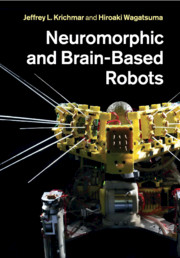Book contents
- Frontmatter
- Contents
- Contributors
- Preface
- Part I Introduction
- 1 History and potential of neuromorphic robotics
- Part II Neuromorphic robots: biologically and neurally inspired designs
- Part III Brain-based robots: architectures and approaches
- Part IV Philosophical and theoretical considerations
- Part V Ethical considerations
- Index
1 - History and potential of neuromorphic robotics
from Part I - Introduction
Published online by Cambridge University Press: 05 February 2012
- Frontmatter
- Contents
- Contributors
- Preface
- Part I Introduction
- 1 History and potential of neuromorphic robotics
- Part II Neuromorphic robots: biologically and neurally inspired designs
- Part III Brain-based robots: architectures and approaches
- Part IV Philosophical and theoretical considerations
- Part V Ethical considerations
- Index
Summary
Neuromorphic and brain-based robots are not encapsulated in a single field with its own journal or conference. Rather, the field crosses many disciplines, and groundbreaking neuromorphic robot research is carried out in computer science, engineering, neuroscience, and many other departments. The field is known by many names: biologically inspired robots, brain-based devices, cognitive robots, neuromorphic engineering, neurobots, neurorobots, and many more. Arguably, the field may have begun with William Grey Walter’s turtles, created in the 1950s, whose simple yet interesting behaviors were guided by an analog electronic nervous system. Another landmark was the fascinating thought experiments in the book by Valentino Braitenberg, Vehicles: Experiments in Synthetic Psychology. Braitenberg’s Vehicles inspired a generation of hobbyists and scientists, present company included, to use synthetic methodology (Braitenberg’s term) to study brain, body, and behavior together. We like to think of synthetic methodology as “understanding through building” and it is certainly an apt mission statement for neuromorphic and brain-based robots.
Information
- Type
- Chapter
- Information
- Neuromorphic and Brain-Based Robots , pp. 3 - 8Publisher: Cambridge University PressPrint publication year: 2011
